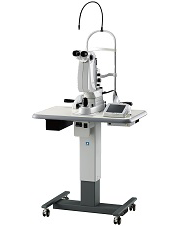- Glaucoma contents
Our instruments for treatment and examination for glaucoma
-
SLT (Selective Laser Trabeculoplasty)
-

-
This treatment improves the flow and reduces intraocular pressure by using a laser onto the pigment cells that block the drain of aqueous humor.
It is effective for open-angle glaucoma, and can lower the eye pressure by about 25%.*1
The effect of this treatment dicreases in several years, but it can be performed repeatedly again.
It can be done on a day, and it is considered for those who tend to forget or feel troublesome to apply eye drops, and who have difficulty in eye drop treatment due to side effects of medicines.
*1 H Domack, V Schmidt.(2007, March 22) Pressure reduction after selective laser trabeculoplasty with two different laser systems and after argon laser trabeculoplasty--a controlled prospective clinical trial on 284 eyes. Retrieved from https://pubmed.ncbi.nlm.nih.gov/17385117/#affiliation-1
-
-
Goldmann Perimetry(GP)
-

-
It can measure dynamic visual field. It is also used to check 180°view angle and can figure out the shape of overall view field.
-
-
DRI OCT Triton (Optical Coherence Tomography)
-

-
It can examine the thickness of retina and nerve by ”Near‐infrared spectroscopy (NIRS)” and detect the nerve fiber layer defect.
It can bring reliable judgment for follow-up and effect of medicines.
-
-
Humphrey Field Analyzer (HF)
-

-
This is used to examine the center part of visual field in detail. This is suitable to diagnosis and follow-up of glaucoma.
-
-
Frequency doubling technology (FDT)
-

-
Frequency doubling technology (FDT) is an instrument to determine field vision loss. It is easily used and has high sensitivity to determine the perimeter loss of vision of glaucomatous, retinal, neurological disorder patients.
-


 Glaucoma contents
Glaucoma contents
